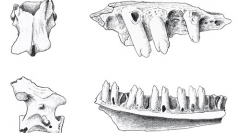

 Geodiversitas
33 (2) - Pages 357-382
Geodiversitas
33 (2) - Pages 357-382The Late Pliocene Capo Mannu D1 Local Fauna (Mandriola, W Sardinia, Italy) produced remains of five amphibians and at least nine reptiles: Salamandrina sp., cf. Ichthyosaura sp., Discoglossus sp., cf. Bufo gr. B. viridis Laurenti, 1768, Hyla gr. H. arborea (Linnaeus, 1758), Gekkonidae indet., Dopasia sp., Lacerta gr. L. viridis (Laurenti, 1768), Lacertidae indet. (small size), Amphisbaenia indet., Eryx cf. E. jaculus (Linnaeus, 1758), Colubrinae indet., Natrix sp., and Vipera sp. The Capo Mannu D1 assemblage partly fills a chronological gap in the knowledge of the Sardinian herpetofauna because well-diversified herpetofaunas have been retrieved only in the Early Miocene of Oschiri and in the Pleistocene of Monte Tuttavista. It has an intermediate taxonomic composition and still shows a high rate of taxa which are now extinct on the island (Salamandrina sp., cf. Ichthyosaura sp., Dopasia sp., Lacerta gr. L. viridis, Amphisbaenia indet., Eryx cf. E. jaculus, and Vipera sp.). Some taxa (both extinct and extant) are present in the three localities but none is exclusively shared by Oschiri and Monte Tuttavista. The remains of Salamandrina from the Capo Mannu D1 Local Fauna testify for a prolonged permanence in Sardinia of this taxon (already known from Oschiri). The absence of remains unambiguously referable to the previously reported ranids could suggest that these anurans never reached the island by natural dispersal (without human intervention). The taxonomic composition of the Capo Mannu D1 Local Fauna is overall similar to that of other west Mediterranean Pliocene herpetofaunas, and it confirms the previously reported pattern of evolution of European herpetofaunas.
Amphibia, Reptilia, Salamandrina, Ichthyosaura, Dopasia, Lacerta, Amphisbaenia, Eryx, Vipera, Late Pliocene, Sardinia